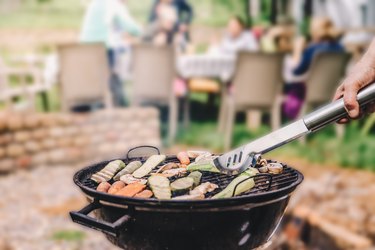
If you don't usually cook for a crowd and love barbecued food, investing in a
small charcoal grill is a good idea.
Cooking burgers and steaks over direct heat on a mini charcoal grill works just as well as on a larger grill. While cooking over indirect heat on a small grill is more of a challenge, a little practice and a few tips will have you grilling like a pro.
Video of the Day
Video of the Day
Things You'll Need
Small grill
Charcoal
Lighter fluid
Long-handled tongs
Grill mitts
Spray bottle of water
Vegetable oil
Aluminum drip pan (optional)
Wire grill brush
Hand broom or stiff brush
How to Start a Small Charcoal Grill
1. Prep the Grill
Place the grill outdoors on a level surface away from overhanging trees, roofs or other structures. Open the bottom vent.
2. Add Charcoal
Remove the lid and grilling rack from the grill. Pile charcoal briquets in a pyramid in the center of the grill. You will need approximately 30 briquettes for every pound of meat you intend to cook. You will need more charcoal on cold, wet or windy days.
3. Add Lighter Fluid
Sprinkle about 2 ounces of lighter fluid onto the charcoal, making sure each briquette gets coated. Carefully light the charcoal with a match. Keep the lid off until the coals are hot and you are ready to cook.
4. Let the Coals Get Hot
Heat the coals for 20 to 25 minutes. By this time, the charcoal should be covered with a layer of white ash.
Warning
Never add lighter fluid to hot coals — the flame could flare up and burn you.
5. Spread Out the Coal
Spread the charcoal out, covering the bottom of the grill for direct grilling or bank them to the side for indirect heat. Use the long-handled tongs to move the coals.
6. Oil the Grill Rack
Use a saturated paper towel or a brush to coat the grill rack with vegetable oil to prevent sticking. Wearing mitts, place the grilling surface back on the grill. Allow the grill surface to heat up before placing food on the grill.
How to Grill Over Direct Heat
- Use the grill vents to control the temperature of the grill. Open the vents all the way for a hot fire or close them partially to lower the heat.
- Place the food in the center portion of the grill for the highest heat or move it to the sides of the grill is too hot.
- Allow the food to brown on one side before turning it. Turning the food too often prevents a nice crust from building and may cause the food to fall apart.
Tip
Keep a spray bottle of water handy for flare-ups. Most flare-ups die out quickly and don't need attention, but spray any large or sustained fires that start. Flare-ups quickly char and leave unpleasant flavors behind.
How to Grill Over Indirect Heat
Use indirect heat for larger cuts of meat such as whole chickens, turkeys and roasts that require longer cooking as well as for fatty meats like duck and for foods like fish fillets that need lower heat.
Grilling over indirect heat is more difficult on a mini charcoal grill because the coal is still close to the cooking surface.
- Move the charcoal to either side of the grill, leaving the center free of coals. Place a drip pan between the coals, if desired, to catch drippings. For foods that require long cooking times, add a thin layer of water to the drip pan.
- Place the meat in the center of the grill.
- Close the lid and keep it closed, lifting it only to baste the meat, check for doneness or add coals.
- Place 16 to 18 additional briquettes around the outside of the hot charcoal and allow them 20 minutes to heat up before they are needed.
Tip
Add more charcoal when you're cooking for a longer period of time. You'll need additional charcoal for each additional hour of cooking time.
How to Clean the Grill
- Close the vents and the lid when cooking is finished and allow the grill to cool for 48 hours before dumping the coals.
- Clean the grill surface with a wire brush, scrubbing to remove any burned-on food.
- Dump the cold ashes and sweep out the bottom of the grill with a hand broom or stiff brush.
Tip
If you have to dispose of hot coals, transfer them individually with long tongs and bury them in a bucket of sand or water.